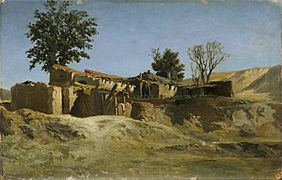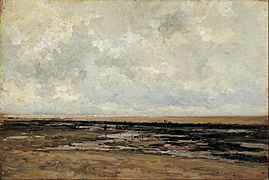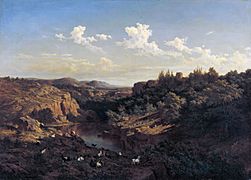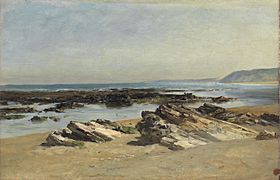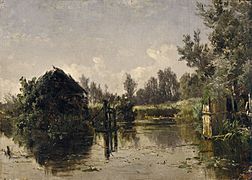Carlos de Haes facts for kids
Quick facts for kids
Carlos de Haes
|
|
|---|---|
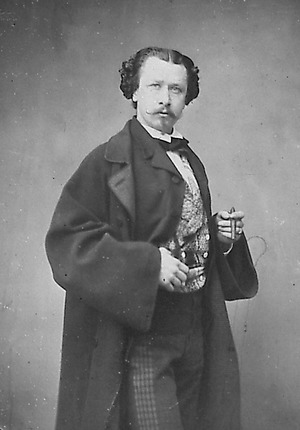 |
|
| Born |
Belgium
|
| Died | June 17, 1898 (aged 69) |
| Nationality | Spanish |
| Known for | Painting |
|
Notable work
|
Monasterio de Piedra |
| Movement | Realism |
Carlos de Haes (born January 25, 1829 – died June 17, 1898) was an important Spanish painter. He was originally from Belgium. Carlos de Haes was famous for his realistic landscape paintings. He was seen as one of the first modern Spanish artists to truly show the spirit of Spain in his art.
Many people consider him one of the three greatest Spanish landscape painters. The other two were Jenaro Perez Villaamil and Aureliano de Beruete. Interestingly, Aureliano de Beruete was one of Carlos de Haes's students.
In the 1850s, Haes played a big part in the rise of the Realist style in landscape painting. He painted landscapes and wildlife, including the Monasterio de Piedra. Around this time, the Real Academia de Bellas Artes de San Fernando was looking for a new professor. They held a competition to find the best landscape painter.
In 1857, Carlos de Haes became the first professor of landscape painting in Spain. He was also the first to teach students to paint outdoors, directly from nature. In 1860, he became a member of the Royal Academy. In 1876, he showed his painting La Canal de Mancorbo en los Picos de Europa at a big art exhibition. The Spanish government bought this painting for the Museo del Prado. It was very important because it showed a realistic Spanish landscape.
Early Life and Training
Carlos de Haes was born in Brussels, Belgium. His family were bankers. In 1835, when he was six years old, his family moved to Spain. They settled in Málaga. There, young Carlos studied art with Luis de la Cruz y Ríos, a portrait painter.
In 1850, Haes decided to improve his art skills. He went to study with famous Flemish landscape masters. He met Joseph Quinaux, who taught him from 1850 to 1855. Quinaux taught Haes to paint outdoors, which greatly influenced his art style. While in Brussels, Haes also saw works by other famous European painters. He traveled around Holland, France, and Germany to learn more.
Painting Career and Teaching

After returning to Spain, Carlos de Haes entered the National Exhibition of Fine Arts. He won a third-place medal for his landscapes painted near Brussels. He was a key figure in the Realist landscape movement that grew in the 1850s.
His paintings of the Monasterio de Piedra helped him get a special job. In 1857, he became a professor of landscape painting at the Real Academia de Bellas Artes de San Fernando. He was the first in Spain to teach students to paint directly from nature. Some of his famous students included Jaime Morera, Aureliano de Beruete, and Darío de Regoyos.
Haes often took his students to paint in the countryside. Thanks to his teaching, many painters learned to explore Spain's landscapes. They used the new railway system to reach far-off places. His art also influenced the Spanish writer Azorín. Azorín improved his writing by often looking at Haes's paintings in the museum.
Carlos de Haes continued to paint a lot. In 1858, he won the first medal at the National Exhibition. In 1860, he became a member of the Royal Academy. He also received a medal for his painting Memories of Andalusia. In 1862, he won another medal for his landscape, Vista del Lozoya.
In 1876, he showed La Canal de Mancorbo en los Picos de Europa again. Even though it didn't win a prize, the Spanish government bought it. It became part of the Museo del Prado collection. This painting was very important because it showed a realistic Spanish landscape. Carlos de Haes became ill in 1890 and passed away in Madrid in 1898.
Art Style
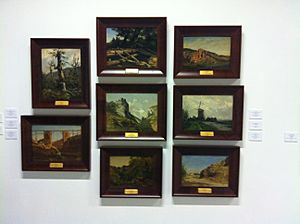
Carlos de Haes believed that art should show the truth found in nature. He thought nature was the source of all beauty. He felt that painters should copy nature as closely as possible. To do this, artists needed to truly know nature, not just imagine it.
He moved away from the Romanticism art style. Instead, he was one of the first to use the En plein air style. This means he made quick sketches outdoors and then finished the paintings in his studio. His brushstrokes sometimes looked like those of Impressionists. However, he didn't focus as much on light and color as Impressionists did.
Later in his career, his style became looser and more direct. This was similar to the Barbizon school of painting. Carlos de Haes created a huge amount of work, including thousands of pictures and notes. You can see his best works in the Carmen Thyssen Museum in Málaga, the Lleida Museum, and the Museo del Prado. The Museo del Prado received 183 of his works from the Museum of Modern Art in Madrid.
See also
- List of artists from the MNAC collection
- In Spanish: Carlos de Haes para niños
Gallery
-
Tileworks in the Principe Pio Mountains
-
Villerville Beach, Normandy
-
View near Monasterio de Piedra
-
Abandoned Canal. Vriesland


